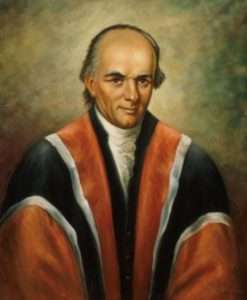The Volokh Conspiracy
Mostly law professors | Sometimes contrarian | Often libertarian | Always independent
Today in Supreme Court History: April 21, 1800
4/21/1800: Justice Alfred Moore takes judicial oath.

Editor's Note: We invite comments and request that they be civil and on-topic. We do not moderate or assume any responsibility for comments, which are owned by the readers who post them. Comments do not represent the views of Reason.com or Reason Foundation. We reserve the right to delete any comment for any reason at any time. Comments may only be edited within 5 minutes of posting. Report abuses.
Please to post comments




City of Austin, Texas v. Reagan Nat’l Advertising of Austin, LLC, 596 U.S. --- (decided April 21, 2022): City ordinance restricting billboards that (like most billboards) are not on land they are advertising for is content-neutral and subject to “intermediate” First Amendment scrutiny; remanded to Fifth Circuit (which then upheld the ordinance, 64 F.4th 287)
United States v. Vaello Madero, 596 U.S. --- (decided April 21, 2022): not denial of Equal Protection to deny SSI benefits to Puerto Ricans; they don’t pay taxes for it (this was a New Yorker who was ordered to pay back benefits awarded after he moved to P.R.)
Jerman v. Carlisle, McNellie, Rini, Kramer & Ulrich LPA, 559 U.S. 573 (decided April 21, 2010): “bona fide error” defense to liability under Fair Debt Collection Practices Act does not apply to mistake of law (here, an incorrectly worded notice from a law firm trying to collect on a mortgage)
United States v. Haggar Apparel Co., 526 U.S. 380 (decided April 21, 1999): Chevron deference (to an agency’s reasonable interpretation of a statute) applied to regulation stating that chemical treatment during assembly (here, men’s trousers) removes imported clothing from duty exemption for articles fabricated here but merely assembled abroad
CSX Transportation, Inc. v. Easterwood, 507 U.S. 658 (decided April 21, 1993): can’t sue train for going unreasonably fast under the circumstances if it was under speed limit set by federal regulation (now that’s what I call preemption!)
United States v. Alaska, 503 U.S. 569 (decided April 21, 1992): Another Chevron deference case, wherein Alaska, whose highways are not of much use, tried to improve its Nome port which in the process would extend Alaska’s border by accretion. The Court upholds the decision of the Secretary of the Army (whose Corps of Engineers would be doing the work) to condition the permit on a waiver of all claims to the new land.
Tison v. Arizona, 481 U.S. 137 (decided April 21, 1987): Under the felony-murder rule, a killing in the process of committing a felony is murder, not manslaughter (cf. the misdemeanor-manslaughter rule), even if the defendant did not do the actual killing. Here the Court upholds the rule against Eighth Amendment attack so long as the participation in the felony is “major” and with “reckless indifference” to human life. (Defendant had helped steal a car after escaping prison, and occupants were shot.)
Larson v. Valente, 456 U.S. 228 (decided April 21, 1982): denial of Equal Protection to restrict charitable solicitation permits given to organizations funded more than 50% by nonmembers
Rosales-Lopez v. United States, 451 U.S. 182 (decided April 21, 1981): at voir dire in violent crime case federal judge, upon request, must inquire into jurors’ racial prejudices, particularly if defendant and victim were different races (here, it was harmless error to deny request)
Cassirer v. Thyssen-Bornemisza Collection Foundation, 596 U.S. --- (decided April 21, 2022): Foreign Sovereign Immunities Act claim against Spanish art foundation (for holding family’s painting extorted by Nazis) was based on state law, so law of forum state (California) applied, not federal common law (the opinion contains the painting, Pissaro’s 1897 “Rue Saint-Honore in the Afternoon, Effect of Rain”, and a photo of it hanging in plaintiff’s grandmother’s Berlin home)
More precisely, it upheld imposing the death penalty for felony murder.
Yes, thanks
When did Supreme Court justices switch from red, white, and blue robes to simple black? Why did they switch?
I think it was Victorian era fashion -- where men's clothes got less dandified and more somber -- which they never got out of.
Or was that a state court robe? Ever see the MD high court today?
I think that’s because Maryland was founded by Catholics and they wanted them to look like Cardinals
Much earlier than that—I believe it’s usually credited to John Marshall.
Captcrisis earned a Noble Prize for Identification of Error in Today in Supreme Court History precisely four years ago.
That might have been the first Noble Prize awarded; it has been far from the last.